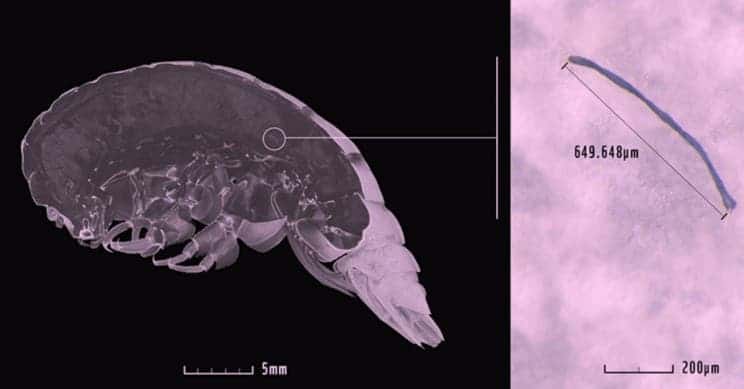Discovery a new species is usually a reason for celebration, especially in the ocean, where up to a million species live and two-thirds of them may still be undiscovered. Nevertheless, the expansion of microplastics in the water in recent years has changed things a bit.

A group of researchers from Newcastle University discovered a new species of a marine creature, a type of crustacean called an amphipod. Their glee was short-lived, however, as they quickly found plastic in its body, showing the large scale of plastic pollution across the globe.
The crustacean was found in the Marina Trench at a depth of roughly 6,000 meters (20,000 feet). But even animals that live in such extreme and ostensibly remote areas of the world are affected by plastic pollution.
Inside the body of the previously unknown amphipod, the researchers found little pieces of plastic debris, called microplastics. The material was identified as polyethylene terephthalate (PET) — a kind of plastic used broadly, in both drink and food packaging.
Consequently, the team at Newcastle decided to call the species Eurythenes plasticus, to forever remind the world about the grim state of the global environment from the effects of pollution. Urgent action needs to be taken to “stop the deluge of plastic waste into our oceans,” said lead author Alan Jamieson in a statement.
“We have new species turning up that are already contaminated and so we have missed the window to understand these species in a natural environment,” said Jamieson to Newsweek. “This discovery exemplifies the extent of the plastic problem. Species in remote and extreme marine environments are suffering as a result of human activity.”
Plastic waste is now found throughout all the world’s oceans. A 2015 study showed that roughly 8 million tons of plastic enter the ocean every single year. Once there, it begins to break down into smaller and smaller pieces, eventually becoming microplastics — that are subsequently eaten by animals.
Microplastics appeared in nature at the same time as plastics, more than 50 years ago. As the world is producing more and more plastic, the number of microplastics continues to grow dramatically. Researchers from several countries are working to understand their distribution and impacts.
The finding by the Newcastle researchers and the decision to name the species linked to plastics was welcomed by environmental organizations. It was a “bold and necessary move,” said the Vice President of Conservation at the World Wildlife Fund (WWF) Lauren Spurrier.
“There can be no disputing the ubiquitous presence of plastics in our environment and its impact on nature,” she said to Newsweek, via a statement. “We now are seeing even more devastating impacts of plastic pollution; in that it is infecting species science is only just now discovering.”
The study was published in the journal Zootaxa.


